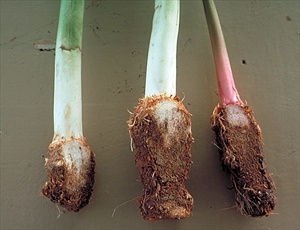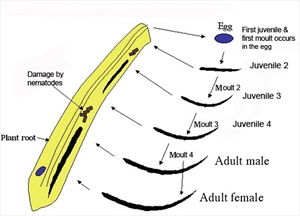Mitimiti disease, Mitimiti corm rot
Pacific Pests, Pathogens, Weeds & Pesticides - Online edition
Pacific Pests, Pathogens, Weeds & Pesticides
Taro Hirschmanniella nematode (010)
Hirschmanniella miticausa
It is known only from Solomon Islands, Papua New Guinea highlands, and Taiwan.
Colocasia taro. It is not known from any other host.
Older leaves wilt, yellow and die prematurely, but often symptoms are not noticeable until harvest when devastation of the corms is seen. The nematode causes a corm rot (Photos 1&2). Corms show irregular zones of a dry, brown rot, 1-10 mm wide, developing from the base. At first, the lines of rot follow the water and food transport systems (i.e., phloem and xylem) inside the corm. Healthy tissue alongside the rots is red and corms look similar to uncooked fatty meat (hence the name 'mitimiti' in Solomon Islands. Often, the bottom part of the corms is completely decayed by brown soft rots (Photo 2). The number of suckers are reduced in plants with the disease.
There is little known about the biology of this nematode: it has not been studied. However, the life cycle is probably typical of other migratory nematodes, with eggs, juveniles (4 stages) and adults of both sexes (Diagram). The eggs are laid in the soil or in the roots, and juveniles and adults (Photo 3) move in and out of the roots. In this way, the life cycle is similar to the lesion nematode, Pratylenchus (see Fact Sheet no. 08).
It is likely that in dryland situations, nematodes move short distance by swimming in films of water around soil particles or are moved greater distances in ground water. In swamps, the nematode spreads by swimming and is moved in water currents.
Spread to new areas is on infected planting material, either in roots and corm pieces or in contaminated soil. How long the nematode can survive in the soil after plants have been harvested is not known.
The nematode reduces plant growth; leaves wilt, there are fewer suckers and corm size is smaller. When severe, most of the consumable part of the corm is destroyed. On the islands of Rennell and Ontong Java, Solomon Islands, where taro are grown in swamps (Photo 4), cultivation has been abandoned, as loss of corm is not worth the efforts of cultivation (Photo 2).
Nematode infection predisposes taro to invasion by secondary pathogens, causing the soft rots invariably associated with mitimiti. Isolations from the diseased corms and roots have found Athelia rolfsii, Pythium vexans and Fusarium species.
Look for the reddening of corms and brown, dry rots at the base of the plant. Nematodes need to be extracted from corms and roots for confirmation.
QUARANTINE
Note, that this disease has only been found on dryland taro on Choiseul, Kolombangara and Rennell, and in the swamps of Ontong Java (Photo 4). Recently, it was found in north Malaita. The spread of mitimiti disease from one island to another should be prevented by local quarantines. For international movement of taro germplasm, the FAO/IBPGR Technical Guidelines for the Safe Movement of Edible Aroid Germplasm should be followed (http://www.bioversityinternational.org/e-library/publications/detail/edible-aroid/).
CULTURAL CONTROL
- The most effective and practical control measure is to "clean" the planting material. Remove the outer leaves and trim the corm back to white healthy tissue, leaving a few centimetres without roots.
- Avoid planting suckers with corms attached. The corm piece below the leaves should always be inspected, even on small suckers, to see if rots are present. Roots should also be removed.
- On hillsides, avoid planting down the slope from gardens where Hirschmanniella was present before, as nematodes may be carried in soil or run-off water to the gardens below.
RESISTANT VARIETIES
There is no information on resistance of varieties, except that a semi-wild variety known as Tiko on Malaita showed resistance to the disease when planted on Ontong Java. This variety was crossed with variety Luhu from Guadalcanal. Other Solomon Islands varieties were crossed with a wild variety from Bangkok. The result of planting these seedlings on Ontong Java is unknown.
HOT WATER TREATMENT
- Treat planting material with hot water. Use the same treatment recommended for yam and ginger - 51°C for 10 minutes (alternatively, 50°C for 15 minutes).
- Measure the temperature carefully with a thermometer: do not guess! Also, treat "tops", leaving more than 1 cm of corm tissue attached.
- Initially, treat a small numbers of taro to establish a source of nematode-free planting material. Do not treat all the taro at one time. Test the method on a few plants first.
AUTHORS Helen Tsatsia & Grahame Jackson
Information from Carmichael A, et al. (2008) TaroPest: an illustrated guide to pests and diseases of taro in the South Pacific. ACIAR Monograph No. 132, 76 pp. (https://lrd.spc.int/about-lrd/lrd-project-partners/taropest); and from Bridge J, et al. (1983) Hirschmanniella miticausa n. sp. (Nematoda : Pratylenchidae) and its pathogenicity on taro (Colocasia esculenta). Revue Nematol 6(2): 285-290. (https://horizon.documentation.ird.fr/exl-doc/pleins_textes/pleins_textes_5/pt5/nemato/15584.pdf). Photo 3 Hanny van Megen, Wageningen UR. (www.wgeningenur.nl). Diagram Sailaja K Nematode biology, Physiology and Ecology.
Produced with support from the Australian Centre for International Agricultural Research under project PC/2010/090: Strengthening integrated crop management research in the Pacific Islands in support of sustainable intensification of high-value crop production, implemented by the University of Queensland and the Secretariat of the Pacific Community.








